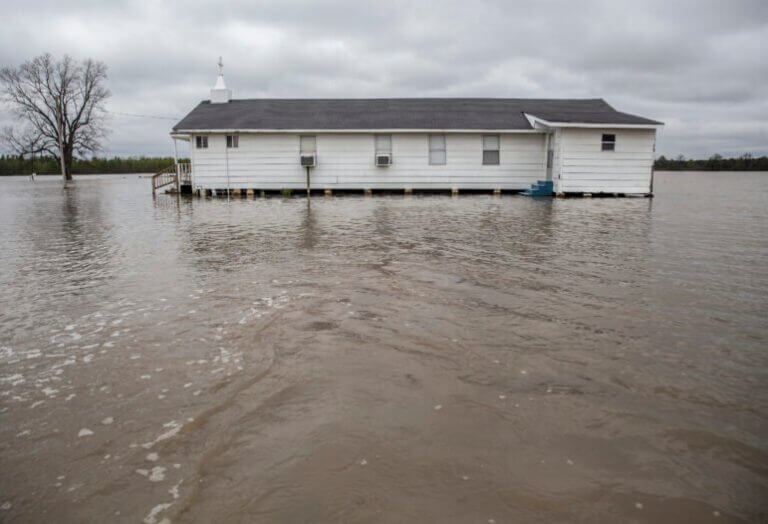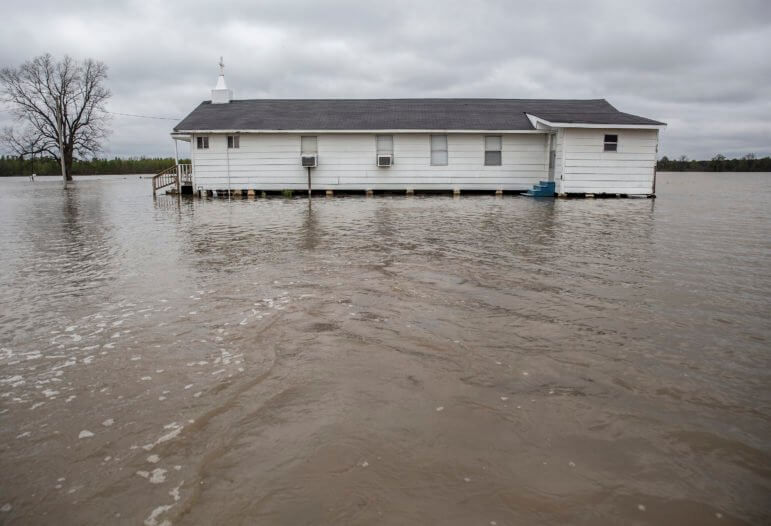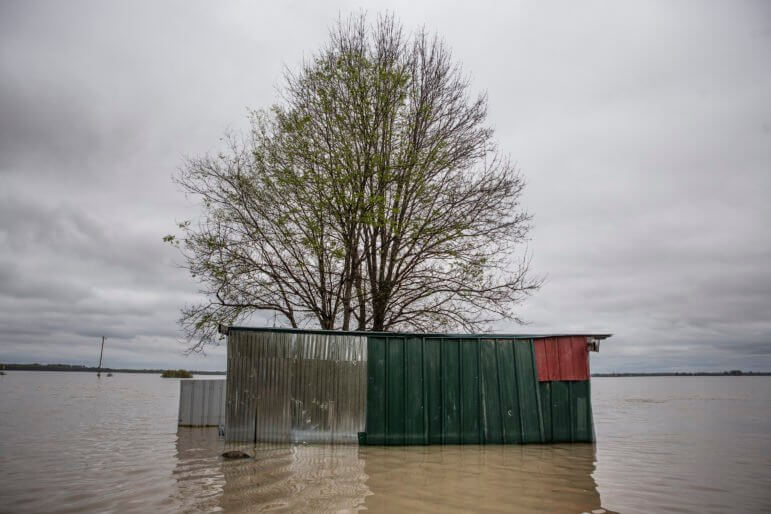

Eric J. Shelton, Mississippi Today/Report For America
Flood waters surround Pleasant Grove Baptist Church in the Goose Lake community of Issaquena Count on April 5, 2019.
The U.S. Army Corps of Engineers says an updated study and proposal for the flood control project known as the Yazoo Pumps will not have a detrimental effect on South Delta wetlands, while environmental groups and experts fear the project would dry up a valuable ecosystem.
The Corps, which is taking public comments on the proposal until Nov. 30, released the new data last month for the proposed pumps which would be built just north of Vicksburg.
During two straight springs that saw over a half million acres of flooding in the Delta — caused by a combination of heavy rainfall and a rising Mississippi River — residents in the area have organized to appeal for a review of the pumps project, which the U.S. Environmental Protection Agency vetoed funding for in 2008 after concerns that it would dry up wetlands.
Several Mississippi politicians in both parties on the state and federal level, namely Sen. Cindy Hyde-Smith, led that recent charge, and last year the EPA agreed to give the project another look.
Specifically, the Corps set out after the 2008 veto to show which water sources sustain the South Delta’s wetlands, which conservationists have called some of the most valuable habitat in the country, especially for migratory birds. After collecting a decade’s worth of groundwater and soil observations, the Corps published a peer-reviewed study showing that 87% of the wetlands are sustained by precipitation, as opposed to the springtime flooding.
Dr. Jacob Berkowitz, a scientist with the Corps and one of the study’s authors, explained that most of the area receives the water necessary for sustaining wetlands from rainfall in the winter, suggesting that the water from the spring flooding could be removed without harming the local ecology.

Eric J. Shelton, Mississippi Today/Report For America
A car is nearly submerged in flood water in Issaquena County Friday, April 5, 2019.
“Even if the pumps operate, they’re not going to convert those areas from wetlands to non-wetlands,” Berkowitz said. “The wetlands have already experienced their natural pattern of hydrology before (the flooding) occurs.”
Yet some experts in the environmental community aren’t as convinced by the new research. Dr. Alex Kolker, of the Louisiana Universities Marine Consortium, said the study lacked modeling of what would happen when the pumps are actually in use.
“I don’t doubt at all that the local rainfall contribution could be extensive,” Kolker told Mississippi Today. “But it doesn’t change my primary concern, which is that over-extensive pumping will lower the water table and dry out the soil.”
After the Corps released its new proposal, which is still in the draft stage, several conservation groups — including American Rivers, Audubon Mississippi, Healthy Gulf, Mississippi River Network and Mississippi Sierra Club — immediately called for the federal government to abandon the project and instead consider alternatives for flood relief.
“This area is home to 17 state and federal threatened and endangered species and is a critical pitstop for migrating fish, birds and wildlife that travel along the Mississippi River Flyway,” said Kelly McGinnis, executive director of the Mississippi River Network. “Losing these wetlands will hurt the entire Mississippi River.”
Earlier this year, American Rivers listed the Big Sunflower River as one of the nation’s most endangered streams because of momentum around the Yazoo Pumps. It also included a list of alternatives — such as voluntary buyouts and elevating structures — that would be cheaper than the pumps, which would likely cost upwards of $300 million.

Eric J. Shelton, Mississippi Today/Report For America
Flood waters surround a property in Issaquena County Friday, April 5, 2019.
The flooded area includes a quarter million acres of farm land — largely crops of soybeans, corn, and cotton — and the last two years Delta farmers have experienced significant financial setbacks, missing entire growing seasons. In a presentation last year, Agriculture and Commerce Commissioner Andy Gipson estimated that the state saw a loss of $500 million worth of crops.
Conservationists who oppose the pumps project argue that the project is more intended to salvage farm revenue rather than to see flood protection for homeowners.
Kolker, the LUMCON professor, added that there are larger issues at play than just the pumps themselves. The Mississippi River is flooding more frequently, a phenomenon most researchers attribute in part to climate change. Others also believe it is due to increased channelization of the river, as well as flood control structures built through the river’s basin such as the Old River Control Structure in Louisiana.
“The hypothesis is that sedimentation just downstream of the Old River Control Structure is causing a change in the slope of the Mississippi River,” Kolker explained, “and that is contributing to increased flooding in this region. That’s one of the pieces I think makes it a bigger picture story than just these pumps. Is (the pump project) a shorter term solution? Is it the right solution?”
For information on submitting a comment to the Corps, click this link.
The post Yazoo Pumps proposal released with new research, but concerns over wetlands and cost remain appeared first on Mississippi Today.
- New Orleans leaders call for transparency during federal immigration sweep - December 5, 2025
- U.S. Supreme Court hears case from Mississippi preacher over city of Brandon’s protest restrictions - December 5, 2025
- Here’s a first look at Brain Drain survey results. We still want to hear from more of y’all - December 5, 2025